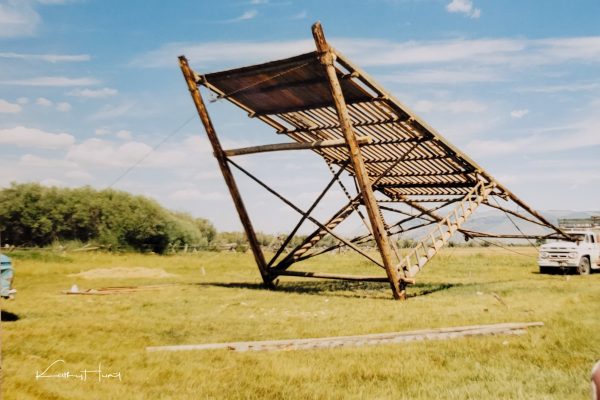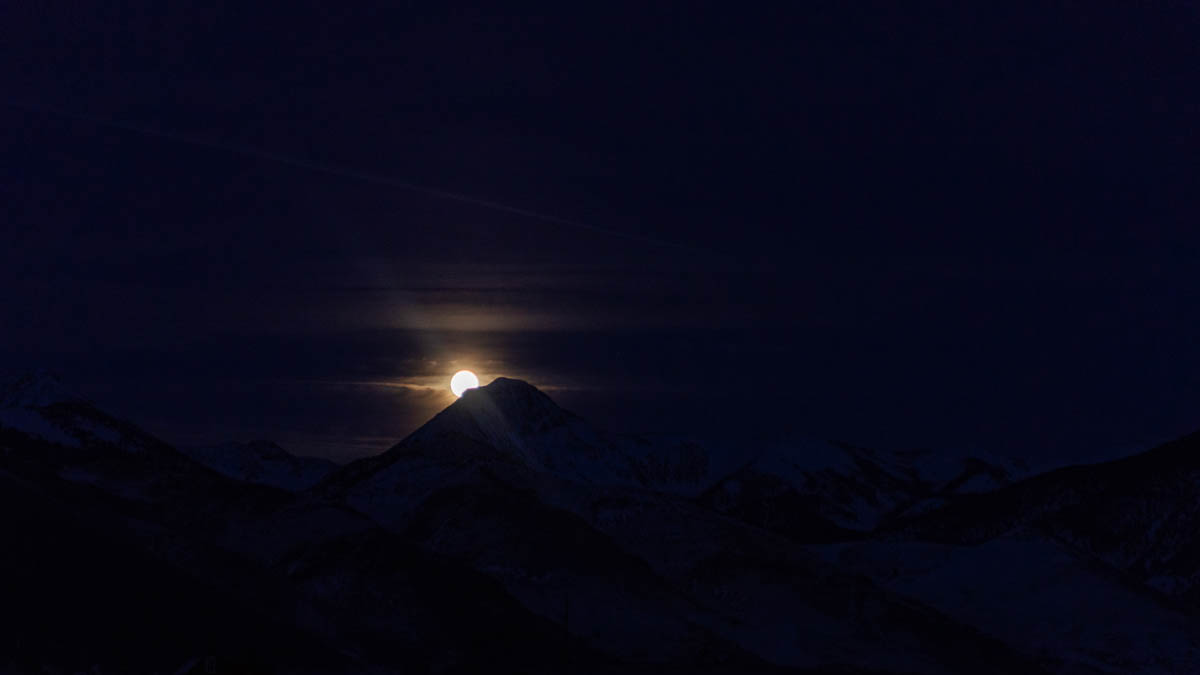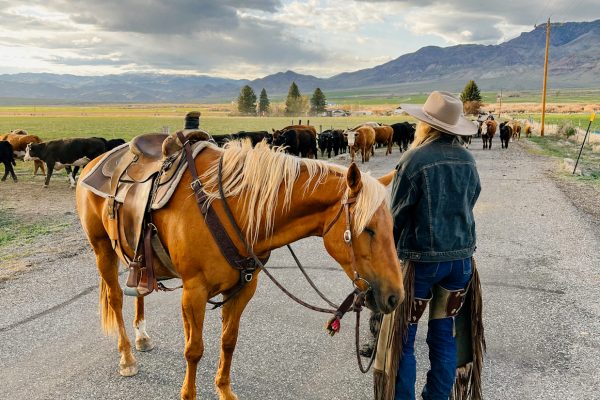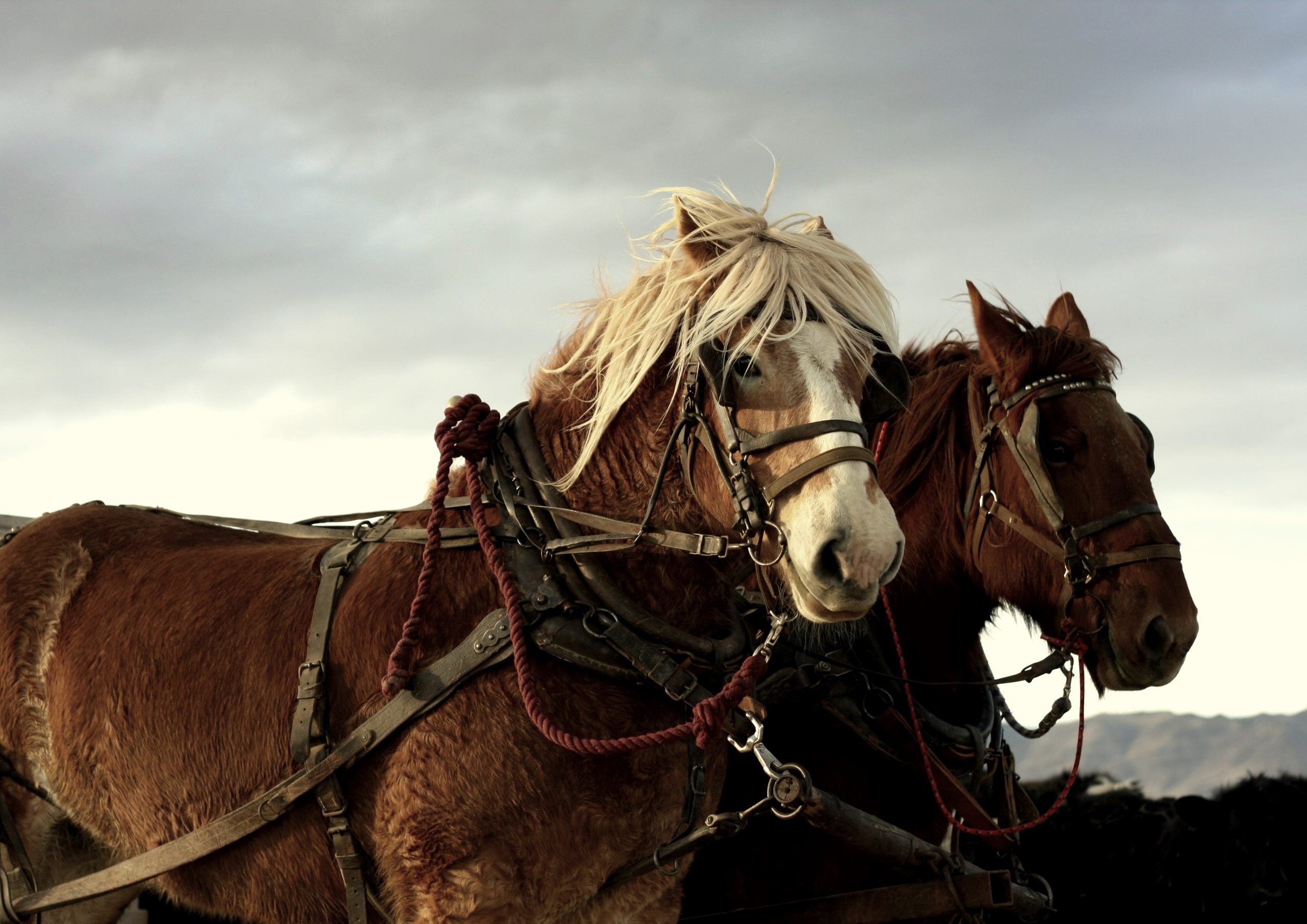A soft wool blanket of low clouds and wispy bands of fog lay over the ranch in the early light this morning. In the dim gray of predawn, I met our head of ranch security on the way to my ranch office, the old bunkhouse. It was Jackie, a.k.a. White Dog, the Great Pyrenees that traverses a big circle patrol around the homestead all through the night, keeping coyotes, foxes and wandering wolves at distance.
I dug my hands into her thick ruff, and massaged her neck for a minute when she came bounding up to me with her 145 pound frame of fur and muscle. It was pure pleasure for her, and the least I could do to express my gratitude. We haven’t even lost even a chicken. She will go with the kids on their random forays across the wilderness of the river bottoms, and stick like glue to their sides, always protecting her charges.
I feared for the two legged midnight thieving intruder that may venture near, uninvited. Jackie’s night vision is legendary, and a thief’s is not. They wouldn’t have a chance against her; when she rears up playfully to me, her head is nearly the height of mine, even with my six and half foot height. Thankfully, we do live in the middle of nowhere, and we’ve never had an intruder. I don’t even know how to lock the doors on the house if we wanted to.
I have no idea where house keys are.
​​​​​​​It’s not like we have anything worth stealing. Our house is filled with unfence-able goods. The ubiquitous across America big flat screen TV doesn’t exist. There’s only an ancient stereo that the kids have wired to their phones to play Spotify and a little TV we hook up to a computer to stream digital entertainment. We have lots of books. Our china doesn’t match. There’s no heirloom jewelry or silver to be had. The possessions we value in our lives are walking four-legged out in the meadow rather than inside bureau drawers.
It would be quite a sad robbery I’m afraid. I can imagine it something like this. We come home, and find would-be thief sitting on the couch, nervously sipping a cup of coffee that he helped himself to. “Hi,†he’ll say. “I’m Joe, and I came to rob your house.†He stands up to shake my hand, cup of coffee in the other. “I hope you don’t mind if I made myself at home, but I’ve been trapped in here for quite awhile. Could you get me outta here? I barely made it in before that white beast got to me, and I’m not ready to go back out there alone.†White beast can be seen at the front door glass, looking in, slowly wagging her massive tail, waiting patiently for her moment to unleash fury on Joe of ill intent. The kids don’t call her “White Death†for nothing. Joe will be safe with me. That’s if I don’t abandon him (maybe I should); if one of us accompanies another human, they are safe. They’re good to go. It’s not what you know, but who you know around here.
A few years ago, Jackie patrolled at night with her sister Sophie. One morning at dawn I noticed a car parked on the main road near our driveway. I didn’t think too much about it. A few hours later I headed up to put some mail in the box, and saw the car was still there. As I approached, Jackie and Sophie came from around the backside of the car, tails swinging. It was then I noticed the car was occupied. The man rolled the window down a crack: “I had a flat early this morning, but those dogs won’t let me out to fix it. Can you help me?â€
Our Great Pyrenees are good friends, but they are more. They are part of what allows us to coexist peacefully with our wild yapping coyote neighbors, and other predators that we share this space with. We don’t need to kill these native predators; we just need to redirect them a little. There’s plenty of room and game in the river bottoms, a place we never graze. There is room enough on Alderspring for both wild animals and us as long as we humans aren’t driven to make every inch “productive†in some way that can be measured only by dollars.
As I stepped up the stairs into the old bunkhouse, I remembered the first Pyrenees we had. Her name was Sadie. We were thinking about raising some goats to eat the weeds that are sprinkled within many of our pastures; the goats would fit perfectly with our organic principles of weed hacking and grubbing. Everyone else packs jugs with Monsanto products in them. Or maybe that ubiquitous 2-4,D produced by Dow that kills plants quite efficiently.
Goats, on the other hand, don’t kill weeds, but eat them, again and again, slowly but surely weakening their grasp on our land. We could eventually triumph over weeds with goats. But I knew that the goats would just become coyote food. The nightly choral requiem of ‘yotes in the nearby river bottoms was a grim reminder of what would be become of sheep or goat.
Enter Sadie, raised by us from a tiny pup. She believed that she was one of the kids, and slept with them for the first year, until her unwieldly 150lb size earned her a spot out the front door. She was simply too big to have with 9 of us in our tiny 1100 square foot ranch house, so out she went. She was good with it. She loved the big open.
The goats came soon after, but only after I fully understood what we had in Sadie. We were calving at the time; it was a day much like today; lightly raining, and all of our Angus cows heavy with calf were across the road from where our house was in those days. It was about a half mile away. Babies were falling to ground daily, almost with abandon, as their Moms found quiet places to lie down and birth them throughout the 40 acre meadow. I was up pretty early, and was heading down to the barn in the soft light of dawn, when over the sound of sandhill cranes calling, I heard Sadie’s low rolling bark in the distance.
It was from where the cows were calving. I could hear coyotes in the farther distance, and could barely spot the salt like speck of white dog among the black pepper of Angus across the back road in the big pasture. I smiled as I went about my business. She was hard at work on her newly minted entrepeneurship: head of ranch security.
An hour later, she was still there. Now, she was silent, and even though she was over half a mile away, I could tell she was looking at me. She let out a rolling bark. Directed at me.
It was all it took. There had to be something wrong. I jumped in the pickup and headed over.
Her broad tail wagged with broad sweeps of joy as I pulled up. She had been waiting for me likely most of the night, and had held her station of duty religiously. I walked the last 50 feet up to her in the tall brown grass. As I approached, she nosed down to the ground and nuzzled a newborn calf, still damp with afterbirth and the misty rain. It had to have been left there in the night, and now was abandoned by mom. It would have been tender morsels for coyotes who tirelessly roam the pasture at night. But Sadie watched mom disengage and leave baby, and stood guard, and the coyotes missed a veal meal.
I let out a calf bawl. Now, dear reader, you might think “how does a person bring himself to a calf bawl?†But I’ll tell you, it comes after years of being on pasture with calving cows. You listen, attempt a bawl, and see what the response is. It’s the language of cow. There are alarm calls, hungry calls, and where’s- my-mom calls.
You have to sound convincing for it to work. Sure, mom knows her baby’s voice specifically, but she’ll check just to make sure if you sound like a calf. So you practice, and after several years, well, you find out what works and doesn’t work. The key is to get mom’s attention, and the moms of newborns, they pay attention. It’s in them to do so, and if it isn’t, they aren’t a good mom.
I figured it was one of the few young first-calf cows that dumped her baby. She probably had a hard labor in the night, didn’t even know what was going on, and when she saw that thing on the ground behind her, got up and ran, freaked out by what just happened. It doesn’t occur very often, but it happens.
I bawled again. A hundred moms in the field looked from their grass and their babies at me. About half of them with calves ran over to their kids and sniffed them just to make sure they hadn’t lost track, then looked back at me and glared. I scanned the horizon for just one cow that would take a step toward me, stare back at me with head held up high with alarmed intensity, and maybe a little indignation.
I let out my alarm bawl. The “mom where are you the coyotes are about to eat me bawl.†There. Behind about 12 moms standing in a row 150 feet away, all looking at me, one was moving furtively behind them, with eyes fixed on me, head held high, from 200 feet away. She stopped behind one old girl and intensely stared at me as the wheels of thousands of years of instinct creaked to a start.
It was time to pull out the big guns with the best alarm bawl I could muster: “Mom you have gotta save me! This coyote is chewing on my ears!â€
It was all it took. She came running. Fast. With an angry moo to boot. I backed off to the pickup to see how things would go and to protect my own hide. Sadie backed up a little, but not much. She wasn’t ready to relinquish her charge yet.
The mom ignored the white dog, and put her nose and tongue to her baby. “Yep. I did have a baby last night. And here it is, and it is all mine.†Baby stood up roughly at first, wobbled over, and began to nurse, as young mom stood nervously at attention and maternal instinct kicked into high gear. Sadie wandered off, sniffing about the pasture among the deluge of life and birth in the big meadow.
The great white dog walked over to another calf about a hundred feet away, and sniffed his nose. The calf’s mom watched , and did nothing, and directly went back to grazing. Sadie sniffed another. Although I’ve seen this before, I stood amazed at the uncanny way that cows know that Pyrenees, of all canines, are their ally. If a border collie did that, Cow would come unglued and try to mortally pummel the unwary pup into the mud. Any other dog wouldn’t have a chance. Cows would be extremely protective and aggressive. Especially the cows we keep.
Their ancient Angus highland bloodlines are fiercely protective of their young. These are not docile spotted milk cows. All of us ranchers who raise Angus cattle have been rolled a time or two by a protective mom when we got too close to their young. I know many neighboring ranchers that have ended up in a hospital bed after tangling with a protective mama cow.
The mamma cows will try to kill a cow dog like a border collie, or a lab (who means no harm), or a coyote (who usually does mean harm). But this white dog, this ancient blood-lined guardian shepherd from the Alpine border between Spain and France, speaks peace to bovines in ways we humans cannot register. There is some ancient understanding passed down between the two lineages that the Great White dogs are their help, and protectors. It’s not like I could have ever told them.

​​​​​​​
There’s so much to learn from these animals. I cringe inwardly every time I hear someone call a cow dumb or a horse stupid. I’m afraid I’ll only use those words for my fellow humans, like that would-be thief who may try to steal from us. I’m just thankful that we have found a place where we can let these charges of ours live their instincts out, free from steel cages, and concrete floors. It’s a pleasure to behold and be part of, and because they can live on their wild instincts, I believe the food they produce is better for it.
Just as if we live a stressed-out existence, our health falters, so it is with animals. It’s the reason why most dairy cows on 90% of our farms in America today have a life span of somewhere around 5.3 years. Our cows average 14 or 15 years of a productive good life; many go nearly 20. It’s about the lifespan of a wild cow on nutrient dense forage. It’s the difference; a testimony of the contrast between cow on concrete and grazer on grass.
And there’s a rightness to grazer on wild grass. Thanks for being part of right.










Leave a Reply